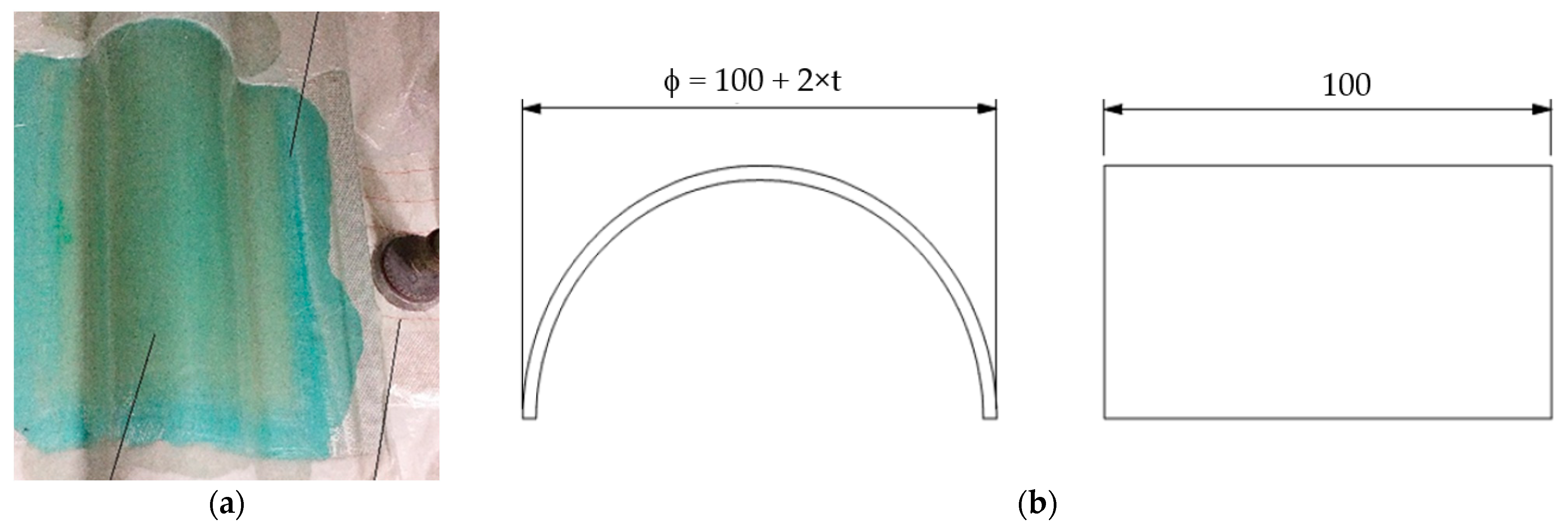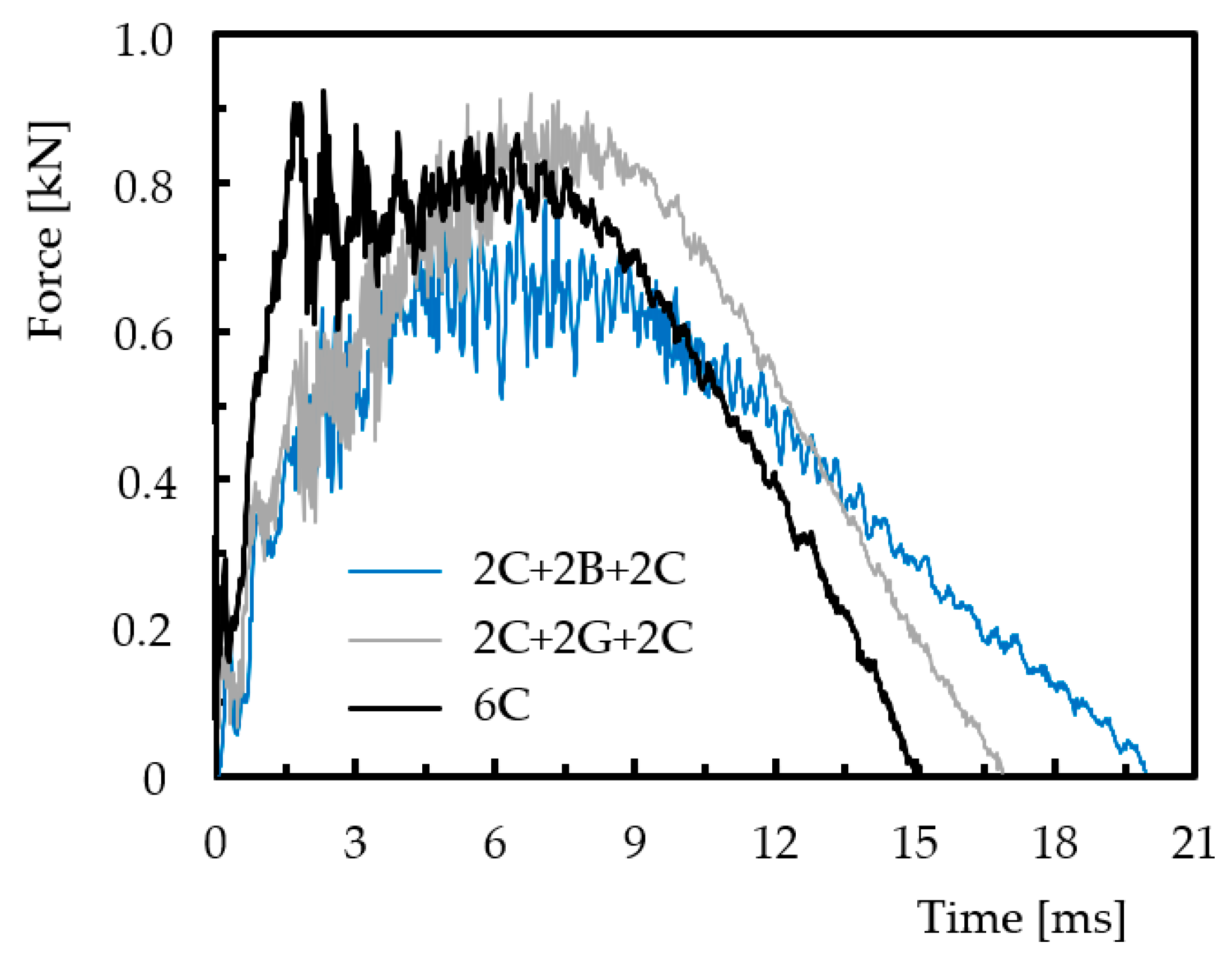Cylindrical Sandwich Shells for Civil Engineering Applications †
Abstract
:1. Introduction
2. Experimental Procedure
3. Results and Discussion
4. Conclusions
Author Contributions
Funding
Institutional Review Board Statement
Informed Consent Statement
Data Availability Statement
Conflicts of Interest
References
- de Moura, M.F.S.F.; Marques, A.T. Prediction of low velocity impact damage in carbon-epoxy laminates. Compos. Part A Appl. Sci. Manuf. 2002, 33, 361–368. [Google Scholar] [CrossRef]
- Richardson, M.O.W.; Wisheart, M.J. Review of low-velocity impact properties of composite materials. Compos. Part A Appl. Sci. Manuf. 1996, 27, 1123–1131. [Google Scholar] [CrossRef]
- Río, T.G.; Zaera, R.; Barbero, E.; Navarro, C. Damage in CFRPs due to low velocity impact at low temperature. Compos. Part B-Eng. 2005, 36, 41–50. [Google Scholar] [CrossRef]
- Aktas, M.; Atas, C.; Icten, B.M.; Karakuzu, R. An experimental investigation of the impact response of composite laminates. Compos. Struct. 2009, 87, 307–313. [Google Scholar] [CrossRef]
- Kulkarni, M.D.; Goel, R.; Naik, N.K. Effect of back pressure on impact and compression after-impact characteristics of composites. Compos. Struct. 2011, 93, 944–951. [Google Scholar] [CrossRef]
- Reis, P.N.B.; Sousa, P.; Ferreira, L.M.; Coelho, C.A.C.P. Multi-impact response of semicylindrical composite laminated shells with different thicknesses. Compos. Struct. 2023, 310, 116771. [Google Scholar] [CrossRef]
- Mortas, N.; Er, O.; Reis, P.N.B.; Ferreira, J.A.M. Effect of corrosive solutions on composites laminates subjected to low velocity impact loading. Compos. Struct. 2014, 108, 205–211. [Google Scholar] [CrossRef]
- Amaro, A.M.; Reis, P.N.B.; Magalhães, A.G.; de Moura, M.F.S.F. The Influence of the boundary conditions on low-velocity impact composite damage. Strain 2011, 47, e220–e226. [Google Scholar] [CrossRef]
- ASTM-D7136; Standard Test Method for Measuring the Damage Resistance of a Fiber Reinforced Polymer Matrix Composite to a Drop-Weight Impact Event. ASTM International: West Conshocken, PA, USA, 2007.
- Coelho, C.A.C.P.; Navalho, F.V.P.; Reis, P.N.B. Impact response of laminate cylindrical shells. Frat. Integrità Strutt. 2019, 48, 411–418. [Google Scholar] [CrossRef]
- Giancaspro, J.W.; Papakonstantinou, C.G.; Balaguru, P.N. Flexural response of inorganic hybrid composites with E-glass and carbon fibers. J. Eng. Mater. Technol. 2010, 132, 021005-1–021005-8. [Google Scholar] [CrossRef]
- Reis, P.N.B.; Coelho, C.A.C.P.; Navalho, F.V.P. Impact Response of Composite Sandwich Cylindrical Shells. Appl. Sci. 2021, 11, 10958. [Google Scholar] [CrossRef]
- Schoeppner, G.A.; Abrate, S. Delamination threshold loads for low velocity impact on composite laminates. Compos. Part A Appl. Sci. Manuf. 2000, 31, 903–915. [Google Scholar] [CrossRef]
- Belingardi, G.; Vadori, R. Low velocity impact of laminate Glass-Fiber-Epoxy matrix composite materials plates. Int. J. Impact Eng. 2002, 27, 213–229. [Google Scholar] [CrossRef]




| Cylindrical Shells | Maximum Force (N) | Displacement at Max. Force (mm) | Stiffness (N/mm) | |||
|---|---|---|---|---|---|---|
| Average | Std. | Average | Std. | Average | Std. | |
| 6C | 873 | 121 | 4.4 | 1.0 | 354 | 41 |
| 2C+2G+2C | 722 | 184 | 7.1 | 1.9 | 203 | 54 |
| 2C+2B+2C | 680 | 201 | 7.3 | 1.4 | 198 | 39 |
| Cylindrical Shells | Peak Force (kN) | Max Displacement (mm) | Elastic Recuperation (J) | |||
|---|---|---|---|---|---|---|
| Average | Std. | Average | Std. | Average | Std. | |
| 6C | 0.924 | 0.12 | 7.8 | 1.9 | 1.71 | 0.91 |
| 2C+2G+2C | 0.916 | 0.21 | 9.5 | 3.1 | 2.14 | 0.98 |
| 2C+2B+2C | 0.774 | 0.26 | 10.5 | 0.8 | 1.30 | 0.72 |
Disclaimer/Publisher’s Note: The statements, opinions and data contained in all publications are solely those of the individual author(s) and contributor(s) and not of MDPI and/or the editor(s). MDPI and/or the editor(s) disclaim responsibility for any injury to people or property resulting from any ideas, methods, instructions or products referred to in the content. |
© 2023 by the authors. Licensee MDPI, Basel, Switzerland. This article is an open access article distributed under the terms and conditions of the Creative Commons Attribution (CC BY) license (https://creativecommons.org/licenses/by/4.0/).
Share and Cite
Reis, P.N.B.; Coelho, C.A.C.P.; Ferreira, L.M. Cylindrical Sandwich Shells for Civil Engineering Applications. Eng. Proc. 2023, 53, 14. https://doi.org/10.3390/IOCBD2023-15196
Reis PNB, Coelho CACP, Ferreira LM. Cylindrical Sandwich Shells for Civil Engineering Applications. Engineering Proceedings. 2023; 53(1):14. https://doi.org/10.3390/IOCBD2023-15196
Chicago/Turabian StyleReis, Paulo N. B., Carlos A. C. P. Coelho, and Luis M. Ferreira. 2023. "Cylindrical Sandwich Shells for Civil Engineering Applications" Engineering Proceedings 53, no. 1: 14. https://doi.org/10.3390/IOCBD2023-15196








